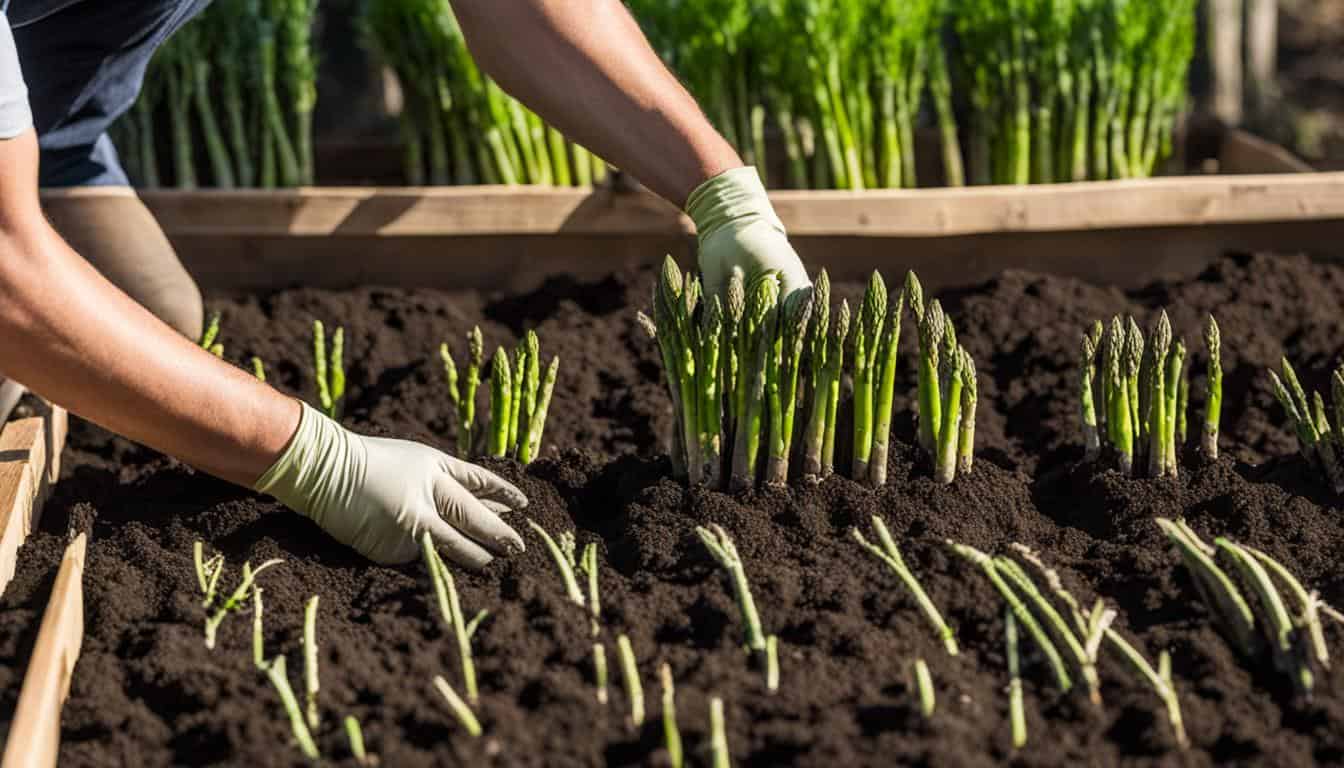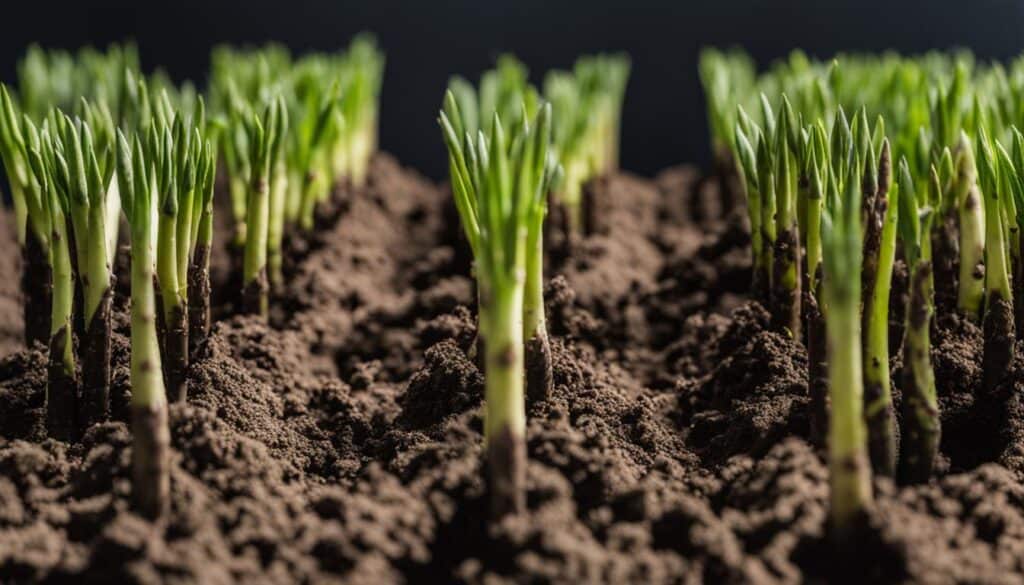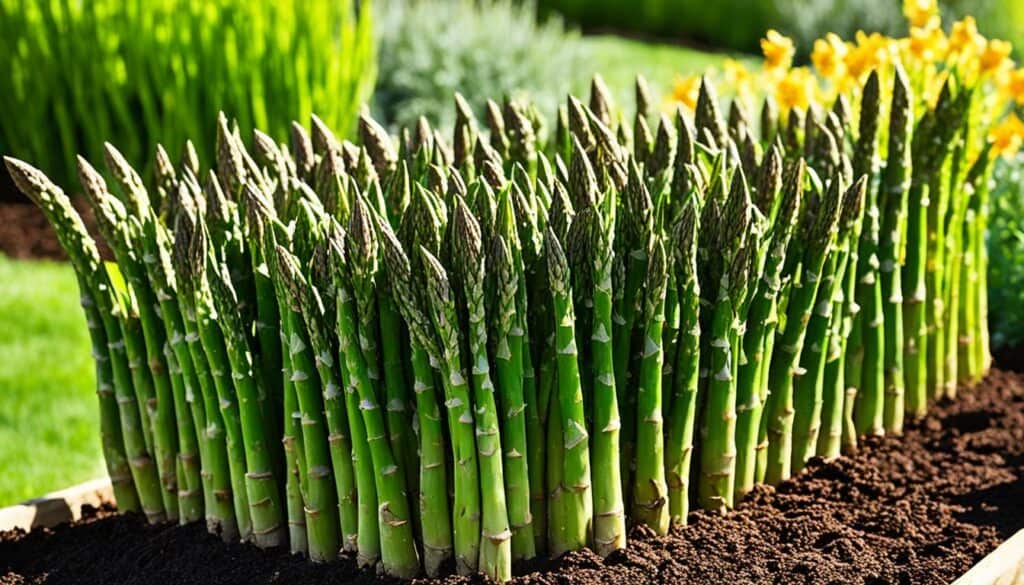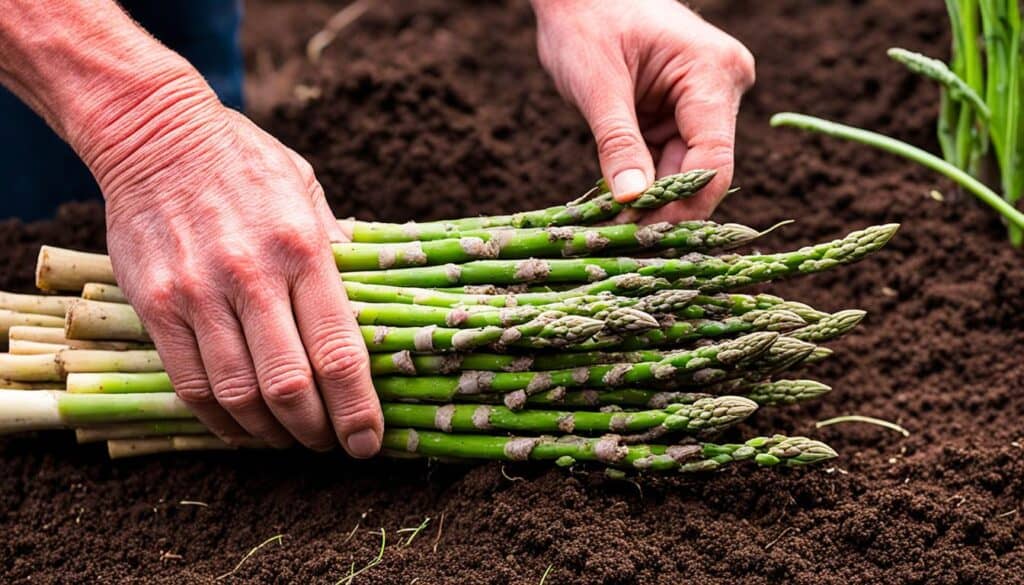Did you know that asparagus is one of the oldest known cultivated vegetables? In fact, this versatile and delicious plant has been grown for over 2,000 years, dating back to ancient Egypt and Greece. But what makes asparagus even more fascinating is its unique way of growing – from crowns. These specialized root systems not only ensure a bountiful harvest but also require specific care and attention. If you’re ready to embark on a journey of growing your own asparagus crowns, read on for expert tips and advice.
Key Takeaways:
- Asparagus has been cultivated for over 2,000 years and grows from specialized root systems called crowns.
- Growing asparagus crowns requires specific care and attention.
- By following expert tips and advice, you can enjoy a lush garden and a bountiful harvest of delicious asparagus.
- Choose the right asparagus crown varieties and prepare the planting site properly.
- Care for your growing asparagus crowns, harvest them at the right time, and provide long-term care for a thriving garden.
Selecting the Right Asparagus Crown Varieties
When it comes to asparagus gardening, choosing the right asparagus crown varieties is crucial for a successful harvest. With a wide range of options available, finding the best asparagus crown suppliers and the perfect variety can be overwhelming. But fear not, I’m here to guide you through the process!
First things first, it’s important to know that asparagus crowns are typically available only once a year, in early spring. So, timing is everything. Start by looking for reputable suppliers that offer high-quality asparagus crowns. Consider visiting local nurseries and garden centers in your area, as they often have a good selection of varieties suited to your local climate and soil conditions.
Now, let’s dive into the exciting world of asparagus crown varieties. When selecting the right variety, you have two main options: hybrid and open-pollinated varieties.
Hybrid Varieties
Hybrid varieties like Jersey Knight or Millennium are popular choices among asparagus growers. These varieties are known for their vigorous growth and excellent disease resistance. They also tend to produce more spears per plant, ensuring a bountiful harvest. So, if you’re looking for a variety that is easier to grow and yields abundant spears, hybrids might be the way to go.
Open-Pollinated Varieties
On the other hand, open-pollinated varieties like Martha Washington or Mary Washington have a long-standing reputation for their delicious flavor. These varieties have been favorites among asparagus enthusiasts for generations. While they may not produce as many spears per plant as hybrids, their taste and texture are often considered superior. Open-pollinated varieties are a great choice if you prioritize flavor and tradition in your asparagus garden.
When selecting the crowns, opt for 1 to 2-year-old plants. These younger crowns will establish faster and provide you with a harvest in a shorter period. Now that you understand the basics of selecting asparagus crown varieties, it’s time to get ready for planting and embark on your journey towards a bountiful asparagus harvest!
{/* Inspired by HTML structure found on: https://www.gardeningknowhow.com/garden-how-to/gardening-by-zone/zone-9-10-11/perennial-vegetable-gardening.htm */}
| Hybrid Varieties | Open-Pollinated Varieties | |
|---|---|---|
| Jersey Knight | Martha Washington | |
| Millennium | Mary Washington | |
| … | … |
Preparing the Planting Site for Asparagus Crowns
To ensure the successful growth of your asparagus crowns, it’s important to prepare the planting site properly. Follow these steps to create an ideal environment for your asparagus:
Choose a Sunny Location
Select a spot in your garden that receives full sun for at least 6-8 hours a day. Asparagus plants thrive in sunlight and need it to produce delicious spears. Avoid areas that are shaded by trees or buildings, as this can inhibit their growth.
Clear Weeds and Grass
Before planting your asparagus crowns, remove any weeds or grass from the area. This will prevent competition for nutrients and create a clean space for your plants to grow. Use a garden fork or shovel to effectively remove any unwanted vegetation.
Amend the Soil
Asparagus crowns prefer well-draining soil that is rich in nutrients. Add compost or well-rotted manure to improve the soil’s fertility and structure. Additionally, consider adding organic fertilizer to provide a boost of nutrients for healthy plant growth. Pay attention to the levels of phosphorus and potassium, as these are essential for asparagus development.
Soil pH
Asparagus thrives in a slightly acidic soil pH of 6 to 6.7. Test your soil using a pH testing kit to ensure it falls within the appropriate range. If the pH is too low or too high, you can amend the soil with lime to raise the pH or sulfur to lower it.
Raised Bed or Contained Area
Consider using a raised bed or a contained area for planting your asparagus crowns. This will help prevent the spread of invasive roots and make it easier to control weeds and grass. By containing the asparagus in a designated space, you can ensure optimal growing conditions and protect your garden from potential invasive growth.
By following these steps to prepare the planting site, you’ll set your asparagus crowns up for success. The next section will guide you through the proper planting techniques to ensure healthy growth and a bountiful harvest.
Planting Asparagus Crowns in the Proper Manner
Planting asparagus crowns is a crucial step in establishing a successful and productive asparagus bed. Proper planting ensures healthy growth and abundant harvests for years to come. Let’s explore the step-by-step process for planting asparagus crowns.
Step 1: Digging the Hole
Begin by digging a hole that is 6-12 inches deep and 12 inches wide. This hole will provide enough space for the asparagus crown’s roots to spread out and establish themselves securely in the soil.
Step 2: Spacing the Crowns
Space each individual asparagus crown 12-18 inches apart. This spacing allows each crown to have enough room to grow and develop without competing for resources with neighboring plants. Adequate spacing also promotes good airflow, which helps prevent the spread of diseases.
Step 3: Planting the Crowns
When planting the asparagus crowns, position them with the crown (top-center of the plant) slightly above the roots. This placement ensures that the crown will not be buried too deeply in the soil, as it can cause rotting. The roots should be spread out in the hole you dug earlier.
Step 4: Backfilling and Mulching
After placing the crowns in the hole, gently backfill it with soil, ensuring that the crown is 3-4 inches below the soil surface. Avoid overpacking the soil, as this can create a compacted environment that restricts root growth. Once the planting is complete, water the crowns thoroughly to ensure that they receive ample moisture.
“Proper planting ensures healthy growth and abundant harvests for years to come.”
Finally, apply a layer of mulch around the planted crowns. Mulch helps conserve soil moisture, suppresses weed growth, and insulates the roots from extreme temperature fluctuations.
With these planting techniques, your asparagus crowns will have the best start possible, laying the foundation for a thriving and productive asparagus bed.
Caring for Growing Asparagus Crowns
Once your asparagus crowns are planted and established, they require minimal care. Here are some essential tips to ensure their optimal health and productivity:
- Regular Watering: During the first two years, it’s important to provide consistent moisture to your asparagus plants. Aim for 1-2 inches of water per square foot per week, especially during dry spells.
- Drought Tolerance: Asparagus is a fairly drought-tolerant plant once established. However, it’s still crucial to monitor soil moisture levels and water as needed, particularly in hot, arid climates.
- Strategic Fertilization: Fertilize your asparagus beds before the first shoots appear and again mid-season. Choose organic fertilizers that are higher in phosphorus and potassium to promote healthy frond growth.
- Weed Control: Keep your asparagus bed weed-free to prevent competition for nutrients. Regularly remove any weeds that may pop up, being careful not to disturb the asparagus crowns.
To better understand the care requirements for asparagus crowns, it’s useful to refer to the following table:
| Care Aspect | Details |
|---|---|
| Watering | Regularly provide 1-2 inches of water per square foot per week during the first two years. |
| Drought Tolerance | Established asparagus crowns are fairly tolerant of dry conditions. Monitor soil moisture levels and water as needed. |
| Fertilization | Apply organic fertilizers before the first shoots appear and again mid-season for optimal frond growth. |
| Weed Control | Maintain a weed-free bed to prevent competition for nutrients. Remove weeds regularly, taking care not to disturb the asparagus crowns. |
Harvesting and Enjoying Asparagus Crop
Harvesting asparagus requires patience, but the reward is worth the wait. Follow these tips for growing asparagus crowns to ensure a bountiful harvest of tender, delicious spears.
Harvesting Timeline
Asparagus crowns need time to establish themselves before you can start harvesting. Resist the temptation to harvest any asparagus during the first year. Instead, allow the crowns to grow and strengthen their root systems.
In the second year, you can begin harvesting, but do so lightly. Pick a few spears per plant over a three to four-week period. This allows the crowns to continue growing and develop further for future harvests.
By the third year, you can fully embrace the harvest season. Regularly pick spears throughout a six to eight-week period. Enjoy the delicious bounty as your asparagus plants reach their full potential.
Harvesting Techniques
When it comes to harvesting asparagus, timing and technique are crucial. Here are the steps to follow:
- Choose a sunny morning for harvesting when the spears are at their freshest. They should still be young and tender for the best flavor.
- Hold the asparagus spear near the base and gently snap it off at ground level. This preserves the spear’s tenderness and promotes new spear growth.
- Dispose of any spears that have developed tough, fibrous stems. These are past their prime and won’t provide the same delightful eating experience.
- Cut down any remaining ferns after the harvest season is over. This allows the plants to focus their energy on regrowing their root system for next year’s crop.
“Harvesting asparagus is like opening a gift from nature. Enjoy the process and savor the delicious rewards!”
Asparagus Crop Yield
The amount of asparagus you can harvest each year depends on several factors. These include the number of asparagus crowns planted, their age, and the growing conditions. As a general guideline, you can expect each established asparagus crown to produce around half a pound of spears per season. This amount will increase as the plants mature and multiply.
Storing and Cooking Asparagus
To maximize the flavor and freshness of your asparagus, it’s best to cook it shortly after harvest. If you need to store the spears for a short period, wrap them in a damp towel or paper towel and refrigerate. They will keep for a few days this way.
When cooking asparagus, there are numerous delicious options. From grilling and roasting to steaming and stir-frying, asparagus adds brightness and a subtle, earthy flavor to any dish. Experiment with different recipes and cooking methods to discover your favorite ways to enjoy this versatile vegetable.
| Harvest Year | Harvest Period | Harvesting Technique |
|---|---|---|
| 1st Year | No harvest | N/A |
| 2nd Year | 3-4 weeks | Light harvest |
| 3rd Year+ | 6-8 weeks | Regular harvest |
Long-term Care for Asparagus Crowns
Once you have planted your asparagus crowns and enjoyed a bountiful harvest, it’s important to provide them with long-term care to ensure their continued productivity. Here are some essential tips to help you maintain healthy and thriving asparagus plants:
1. Winter Protection
During the winter months, it’s crucial to protect your asparagus crowns from harsh conditions. Start by cutting back the dormant ferns to about 2 inches above the ground. This helps prevent disease and makes it easier to apply mulch or straw. Cover the entire asparagus bed with a layer of organic mulch or straw, which acts as insulation and keeps the soil temperature stable.
2. Weed Control
Keep a close eye on your asparagus bed and promptly remove any weeds that may emerge. Weeds compete with asparagus plants for nutrients and water, which can hinder their growth. Regular weeding helps ensure that your asparagus crowns receive the full benefits of the available resources.
3. Watering
As asparagus plants mature, they become more drought-tolerant and rely primarily on natural rainfall. However, in dry and hot climates, additional watering may be necessary to keep the soil evenly moist. Water deeply and infrequently, ensuring that the soil is moist to a depth of 6-8 inches. Avoid overwatering, as excessive moisture can lead to root rot and other fungal diseases.
4. Fertilization
Regular fertilization is essential for maintaining the nutrient levels in the soil and promoting healthy asparagus growth. Apply a balanced organic fertilizer in early spring before the new shoots emerge. You can also provide a mid-season fertilizer application to support the development of robust fronds. Choose fertilizers with higher levels of phosphorus and potassium, as these nutrients play a crucial role in asparagus plant development.
5. Pests and Diseases
Monitor your asparagus plants for signs of pests and diseases, such as aphids or fungal infections. Asparagus can be susceptible to certain pests and diseases, but early detection and appropriate measures can prevent severe damage. Use organic insecticides if necessary and practice good sanitation by removing any infected plants or debris immediately.
By following these long-term care practices, you can ensure that your asparagus crowns remain healthy, productive, and provide you with a delicious harvest year after year.
| Long-Term Care Tips for Asparagus Crowns | |
|---|---|
| Protect the crowns during winter | Cut back dormant ferns and apply mulch or straw for insulation |
| Control weeds | Regularly remove weeds to prevent competition for nutrients |
| Watering | Water deeply and infrequently, ensuring even moisture |
| Fertilization | Apply organic fertilizer in early spring and mid-season |
| Pest and disease management | Monitor for pests and diseases, take appropriate measures |
Storing Asparagus Crowns for Later Planting
Asparagus crowns are only available in early spring, so it’s important to plan ahead. To ensure a successful future harvest, it’s crucial to store your asparagus crowns properly if you are not ready to plant them immediately.
When purchasing asparagus crowns, it is recommended to buy from reputable suppliers or local nurseries to ensure you are getting high-quality crowns. This will give you the best chance of having a productive asparagus bed in the future.
If you need to store your asparagus crowns for a short period of time, such as a few days, it is important to keep them in a cool, dark place to prevent them from drying out. One option is to wrap the crowns in damp towels or newspapers to keep them moist. This will help maintain their viability until you are ready to plant them.
For longer storage, it is best to place the asparagus crowns in a loosely sealed plastic bag and store them in the refrigerator. This will provide a cool and consistent environment that will help keep the crowns dormant until you are ready to plant them.
Remember, when handling asparagus crowns, be careful not to expose them to extreme temperatures or excessive moisture, as these conditions can damage their viability.
By following these storage tips, you can ensure that your asparagus crowns remain healthy and ready for planting, allowing you to enjoy a bountiful harvest of delicious asparagus in the future.
Overwintering and Transplanting Asparagus Crowns
Once asparagus crowns become established, they prefer not to be moved. It is important to choose a permanent location for your asparagus bed, considering the space requirements as the ferns can grow up to 5 feet tall. This ensures that the plants have enough room to spread out and grow without being disturbed.
If your dedicated bed won’t be ready for planting, there is an alternative. You can temporarily plant the crowns closer together in a temporary location and transplant them to their permanent position the following spring. However, be cautious when moving the roots to avoid damage and allow them time to recover before the next harvest season.
When transplanting asparagus crowns, gently dig around the roots and lift them out of the ground. Take care to keep as much of the root system intact as possible. Choose a new location with suitable soil and planting conditions, dig a hole, and place the crowns with the roots spread out. Backfill the hole with soil, making sure the crown is covered adequately. Water thoroughly and provide ongoing care to ensure their successful establishment in the new location.
Tips for Transplanting Asparagus Crowns:
- Handle the crowns with care to avoid damaging the delicate roots.
- Choose a location with similar soil and sunlight conditions to ensure successful transplantation.
- Water the transplanted crowns generously to help them settle into their new environment.
- Provide ongoing care, including regular watering and fertilization, to support their growth and development.
Tips and Tricks for Successful Asparagus Gardening
When it comes to growing asparagus crowns, there are a few tips and tricks that can help you achieve success in your garden. Here are some important considerations:
1. Choosing the Right Location
Plant your asparagus in a north or west-facing area of your garden to prevent shading of other vegetables. Asparagus loves plenty of sunlight, so be sure to choose a spot that receives at least 6-8 hours of direct sunlight per day.
2. Consistent Watering
Asparagus requires consistent watering to thrive. Consider using drip irrigation or a soaker hose to provide a steady supply of water directly to the roots. This helps prevent overwatering and ensures the soil remains consistently moist, which is crucial for root development and spear production.
3. Proper Spacing
Avoid overcrowding your asparagus bed to allow for proper airflow and prevent the spread of diseases. Space the crowns according to the specific variety you are planting, but a general guideline is to leave about 12-18 inches between each crown.
4. Pest Control
Monitor your asparagus plants regularly for pests such as aphids or beetles. These insects can cause damage to the foliage and stunt the growth of your plants. If you notice any pest infestations, take appropriate measures to control them. You can use organic insecticides or try natural methods like introducing beneficial insects to your garden.
5. Crop Rotation
To maintain healthy soil and prevent the buildup of diseases and pests, it’s important to practice crop rotation with your asparagus plants. Rotate them with other crops every 4-5 years to minimize disease and nutrient depletion. This helps ensure that your asparagus bed remains productive year after year.
“Proper spacing and consistent watering are key to successful asparagus gardening.”
– Gardening Expert
6. Nutrient Management
To keep your asparagus plants healthy and productive, it’s important to provide them with adequate nutrients. Before planting, amend the soil with compost and organic fertilizer to ensure a nutrient-rich environment. Additionally, consider using a balanced organic fertilizer mid-season to promote healthy frond growth.
7. Harvesting Tips
When it comes time to harvest your asparagus, snap off the spears at ground level when they are young and tender. Avoid harvesting older spears with tough, fibrous stems. This not only ensures better-tasting asparagus but also promotes the development of new spears for future harvests.
8. Winter Care
During the winter months, cut back the dormant ferns of your asparagus plants and apply a layer of mulch or straw to protect the crowns from freezing temperatures. This winter protection helps ensure the survival and vigor of your asparagus bed.
| Tip | Benefit |
|---|---|
| Choosing the Right Location | Prevents shading and provides ample sunlight |
| Consistent Watering | Promotes root development and spear production |
| Proper Spacing | Prevents disease spread and improves airflow |
| Pest Control | Prevents damage and promotes plant growth |
| Crop Rotation | Minimizes disease and nutrient depletion |
| Nutrient Management | Ensures healthy and productive plants |
| Harvesting Tips | Promotes continuous spear production |
| Winter Care | Protects crowns from freezing temperatures |
By following these tips and tricks, you’ll be on your way to a successful asparagus harvest. Remember, growing asparagus crowns requires patience and attention, but the rewards are well worth it. Enjoy the delicious bounty from your garden and share the joy of homegrown asparagus with family and friends!
Common Problems and Solutions for Asparagus Crowns
While growing asparagus crowns can provide a bountiful harvest, it is essential to be aware of common problems that may arise. Diseases like fusarium wilt and rust, as well as pest infestations, can pose challenges. However, by taking preventive measures and implementing proper care, you can overcome these issues and ensure the success of your asparagus crop.
Disease Prevention and Management
One of the key steps in preventing asparagus diseases is selecting disease-resistant varieties when purchasing asparagus crowns. These varieties are specifically bred to withstand common diseases, providing a higher chance of a healthy crop. Additionally, good sanitation practices are crucial for minimizing disease spread. Regularly remove and destroy infected plants and debris to prevent the pathogens from spreading further.
Pest Control
Pests like aphids and beetles can damage asparagus plants and hinder their growth. To control these pests organically, consider using insecticidal soaps or neem oil sprays. These products are effective in managing pests while being safe for the environment. Regularly monitor your plants for any signs of pests, and take immediate action as soon as an infestation is detected.
Proper Watering and Fertilization
To promote healthy growth and minimize stress on asparagus crowns, it is important to maintain proper watering and fertilization. Asparagus generally requires 1-2 inches of water per square foot per week during the first two years, and less once established. Keep the soil consistently moist, but avoid overwatering, as excessively wet conditions can encourage the development of diseases. Fertilize before the first shoots appear and mid-season with organic fertilizers that have higher levels of phosphorus and potassium.
In conclusion, by practicing disease prevention, pest control, and implementing appropriate watering and fertilization techniques, you can successfully overcome common problems that may arise when growing asparagus crowns. With diligence and care, you’ll be able to enjoy a thriving asparagus crop for years to come.
Conclusion
Growing asparagus crowns is a rewarding journey that can yield a bountiful harvest for years to come. By carefully selecting the right planting site, using proper planting techniques, and providing attentive care, you can ensure the success of your asparagus crop.
Remember to choose a sunny location with well-draining soil and amend it with compost and organic fertilizer. Plant the crowns at the correct depth, spacing them adequately and watering them thoroughly. Maintain a regular schedule for watering and fertilization, and control weeds to prevent competition for nutrients.
With patience and dedication, your asparagus crowns will thrive, rewarding you with fresh and delicious spears straight from your garden. Don’t be afraid to experiment with different varieties and techniques to find what works best for you. Enjoy the satisfaction of growing your own asparagus and relish in the flavors of a homegrown harvest!










Leave a Reply